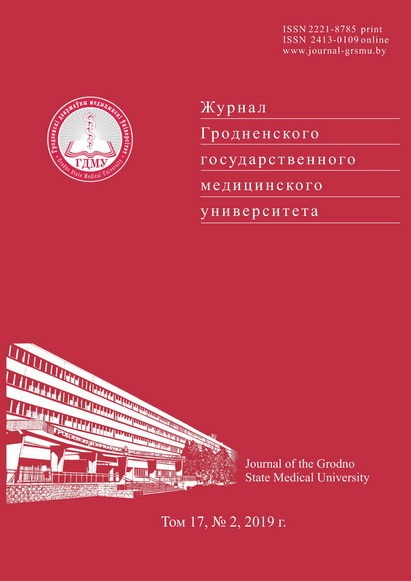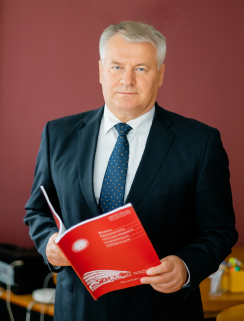УЧАСТИЕ МОНООКСИД УГЛЕРОДА В КОРРЕКЦИИ РЕПЕРФУЗИОНЫХ ПОВРЕЖДЕНИЙ ПЕЧЕНИ
Аннотация
Реперфузионные повреждения печени часто встречаются в клинической практике при выполнении трансплантации, резекции или травмах органа при временной окклюзии магистральных сосудов органа (маневр Прингла). Цель обзора – анализ и обобщение собственных и литературных данных о роли монооксид углерода в развитии и коррекции синдрома ишемии-реперфузии печени в эксперименте.
Литература
Zhang Y, Shen Q, Liu Y, Chen H, Zheng X, Xie S, Ji H, Zheng S. Hepatic Ischemic Preconditioning Alleviates Ischemia-Reperfusion Injury by Decreasing TIM4 Expression. Int. J. Biol. Sci. 2018;14(10):1186-1195. doi: 10.7150/ijbs.24898.
Guan LY, Fu PY, Li PD, Li ZN, Liu HY, Xin MG, Li W. Mechanisms of hepatic ischemia-reperfusion injury and protective effects of nitric oxide. World J. Gastrointest. Surg. 2014;6(7):122-128. doi: 10.4240/wjgs.v6.i7.122.
Rummo OO. Sem let transplantacii pecheni v Respublike Belarus [7 years of liver transplantation in the Republic of Belarus]. Vestnik transplantologii i iskusstvennyh organov [Russian Journal of Transplantology and Artificial Organs]. 2015;17(2):100-104. (Russian).
Bolondi G, Mocchegiani F, Montalti R, Nicolini D, Vivarelli M, De Pietri L. Predictive factors of short term outcome after liver transplantation. World J. Gastroenterol. 2016;22(26):5936-5949. doi: 10.3748/wjg. v22.i26.5936.
Hu XX, Fu L, Li Y, Lin ZB, Liu X, Wang JF, Chen YX, Wang ZP, Zhang X, Ou ZJ, Ou JS. The Cardioprotective Effect of Vitamin E (Alpha-Tocopherol) Is Strongly Related to Age and Gender in Mice. PLoS One. 2015;10(9):e0137405. doi: 10.1371/journal.pone.0137405.
Olson KR. Hydrogen sulfide as an oxygen sensor. Antioxid. Redox Signal. 2015;22(5):377-397. doi: 10.1089/ars.2014.5930.
Kolluru GK, Shen X, Yuan S, Kevil CG. Gasotransmitter Heterocellular Signaling. Antioxid. Redox Signal. 2017;26(16):936-960. doi: 10.1089/ars.2016.6909.
Coburn RF, Blakemore WS, Forster RE. Endogenous carbon monoxide production in man. J. Clin. Invest. 1963;42:1172-1178.
Dawson TM, Snyder SH. Gases as biological messengers: nitric oxide and carbon monoxide in the brain. J. Neuroscience. 1994;14(9):5147-5159.
Suematsu M, Goda N, Sano T, Kashiwagi S, Egawa T, Shinoda Y, Ishimura Y. Carbon monoxide: an endogenous modulator of sinusoidal tone in the perfused rat liver. J. Clin. Invest. 1995;96(5):2431-2437.
Otterbein LE, Foresti R, Motterlini R. Heme Oxygenase-1 and Carbon Monoxide in the Heart: The Balancing Act Between Danger Signaling and Pro-Survival. Circ. Res. 2016;118(12):1940-1959. doi: 10.1161/ CIRCRESAHA.116.306588.
Olas B. Carbon monoxide is not always a poison gas for human organism: Physiological and pharmacological features of CO. Chem. Biol. Interact. 2014;222:37-43. doi: 10.1016//j.cbi.2014.08.005.
Ayer A, Zarjou A, Agarwal A, Stocker R. Heme Oxygenases in Cardiovascular Health and Disease. Physiol. Rev. 2016;96(4):1449-1508. doi: 10.1152/physrev.00003.2016.
Wei Y, Chen P, de Bruyn M, Zhang W, Bremer E, Helfrich W. Carbon monoxide-releasing molecule-2 (CORM-2) attenuates acute hepatic ischemia reperfusion injury in rats. BMC Gastroenterol. 2010;10(42):1-9. doi: 10.1186/1471-230X-10-42.
Niu X, Huang WH, De Boer B, Delriviere L, Mou LJ, Jeffrey GP. Iron-induced oxidative rat liver injury after non-heart-beating warm ischemia is mediated by tumor necrosis factor α and prevented by deferoxamine. Liver Transpl. 2014;20(8):904-911. doi: 10.1002/lt.23893.
Bauer M, Bauer I. Heme oxygenase-1: redox regulation and role in the hepatic response to oxidative stress. Antioxid. Redox Signal. 2002;4(5):749-758.
Khodosovsky MN. Uchastie gazotransmitterov v korrekcii reperfuzionnyh povrezhdenij pecheni [Involvement of gasotransmitters in the correction of liver reperfusion injury]. Grodno: GrSMU; 2017. 212 p. (Russian).
Sener A, Tran KC, Deng JP, Garcia B, Lan Z, Liu W, Sun T, Arp J, Salna M, Acott P, Cepinskas G, Jevnikar AM, Luke PP. Carbon monoxide releasing molecules inhibit cell death resulting from renal transplantation related stress. J. Urol. 2013;190(2):772-778. doi: 10.1016/j. juro.2012.12.020.
Lo Iacono L, Boczkowski J, Zini R, Salouage I, Berdeaux A, Motterlini R, Morin D. A carbon monoxide-releasing molecule (CORM-3) uncouples mitochondrial respiration and modulates the production of reactive oxygen species. Free Radic. Biol. Med. 2011;50(11):1556-1564. doi: 10.1016/j.freeradbiomed.2011.02.033.
Kaizu T, Ikeda A, Nakao A, Tsung A, Toyokawa H, Ueki S, Geller DA, Murase N. Protection of transplant-induced hepatic ischemia/reperfusion injury with carbon monoxide via MEK/ERK1/2 pathway downregulation. Am. J. Physiol. Gastrointest. Liver Physiol. 2008;294(1): G236-244.
Bauer I, Pannen BH. Bench-to-bedside review: Carbon monoxide-from mitochondrial poisoning to therapeutic use. Crit. Care. 2009;13(4):220. doi: 10.1186/cc7887.
Lai IR, Ma MC, Chen CF, Chang KJ. The protective role of heme oxygenase-1 on the liver after hypoxic preconditioning in rats. Transplantation. 2004;77(7):1004-1008.
Choukèr A, Ohta A, Martignoni A, Lukashev D, Zacharia LC, Jackson EK, Schnermann J, Ward JM, Kaufmann I, Klaunberg B, Sitkovsky MV, Thiel M. In vivo hypoxic preconditioning protects from warm liver ischemia-reperfusion injury through the adenosine A2B receptor. Transplantation. 2012;94(9):894-902. doi: 10.1097/TP.0b013e31826a9a46.
Simonson TS, Wei G, Wagner HE, Wuren T, Bui A, Fine JM, Qin G, Beltrami FG, Yan M, Wagner PD, Ge RL. Increased blood-oxygen binding affinity in Tibetan and Han Chinese residents at 4200 m. Exp Physiol. 2014;99(12):1624-1635. doi: 10.1113/expphysiol. 2014.080820.
Khodosovsky MN. Effects of hypoxic preconditioning on the mechanisms of oxygen transport and oxidative damage during hepatic ischemia-reperfusion syndrome in rabbits. International Journal of Physiology and Pathophysiology. 2017;8(2):165-175. doi: 10.1615/intjphyspathophys. v8.i2.70.
Hummitzsch L, Zitta K, Bein B, Steinfath M, Albrecht M. Culture media from hypoxia conditioned endothelial cells protect human intestinal cells from hypoxia/reoxygenation injury. Exp. Cell. Res. 2014;322(1):62-70. doi: 10.1016/j.yexcr.2013.12.022.
Samojlov MO, Rybnikova EA, Churilova AV. Signalnye molekuljarnye i gormonalnye mehanizmy formirovanija protektivnyh jeffektov gipoksicheskogo prekondicionirovanija [Signal molecular and hormonal mechanisms of formation of the hypoxic preconditioning protective effect]. Patologicheskaja fiziologija i jeksperimentalnaja terapija [Pathological physiology and experimental therapy]. 2012;56(3):3-10. (Russian).
Akhtar MZ, Sutherland AI, Huang H, Ploeg RJ, Pugh CW. The role of hypoxia-inducible factors in organ donation and transplantation: the current perspective and future opportunities. Am. J. Transplant. 2014;14(7):1481-1487. doi: 10.1111/ajt.12737.
Khodosovsky MN. Vklad monooksida ugleroda v korrekciju reperfuzionnyh povrezhdenij pecheni metodom gipoksicheskogo prekondicionirovanija [Contribution of carbon monoxide to correction of hepatic reperfusion damages by means of hypoxic preconditioning method]. Zhurnal Grodnenskogo gosudarstvennogo medicinskogo universiteta [Journal of the Grodno State Medical University]. 2017;15(3):324-328. doi: 10.25298/2221-8785-2017-15-3-324-328. (Russian).
Go KL, Lee S, Zendejas I, Behrns KE, Kim JS. Mitochondrial Dysfunction and Autophagy in Hepatic Ischemia/Reperfusion Injury. Biomed. Res. Int. 2015;2015:1-14. doi: 10.1155/2015/183469.
Kim JS, Wang JH, Lemasters JJ. Mitochondrial permeability transition in rat hepatocytes after anoxia/reoxygenation: role of Ca2+-dependent mitochondrial formation of reactive oxygen species. Am. J. Physiol. Gastrointest. Liver Physiol. 2012;302(7):G723-731. doi: 10.1152/ajpgi. 00082.2011.
Schneider M, Van Geyte K, Fraisl P, Kiss J, Aragonés J, Mazzone M, Mairbäurl H, De Bock K, Jeoung NH, Mollenhauer M, Georgiadou M, Bishop T, Roncal C, Sutherland A, Jordan B, Gallez B, Weitz J, Harris RA, Maxwell P, Baes M, Ratcliffe P, Carmeliet P. Loss or silencing of the PHD1 prolyl hydroxylase protects livers of mice against ischemia/reperfusion injury. Gastroenterology. 2010;138(3):1143-1154. doi: 10.1053/j.gastro.2009.09.057.
Liu B, Qian JM. Cytoprotective role of heme oxygenase-1 in liver ischemia reperfusion injury. Int. J. Clin. Exp. Med. 2015;8(11):19867-19873.
Zhong Z, Ramshesh VK, Rehman H, Currin RT, Sridharan V, Theruvath TP, Kim I, Wright GL, Lemasters JJ. Activation of the oxygen-sensing signal cascade prevents mitochondrial injury after mouse liver ischemia-reperfusion. Am. J. Physiol. Gastrointest. Liver Physiol. 2008;295(4):G823-832. doi: 10.1152/ajpgi.90287.2008.
Kim HJ, Zheng M, Kim SK, Cho JJ, Shin CH, Joe Y, Chung HT. CO/HO-1 Induces NQO-1 Expression via Nrf2 Activation. Immune Netw. 2011;11(6):376-382. doi: 10.4110/in.2011.11.6.376.
Bolisetty S, Zarjou A, Agarwal A. Heme Oxygenase 1 as a Therapeutic Target in Acute Kidney Injury. Am. J. Kidney Dis. 2017;69(4):531-545. doi: 10.1053/j. ajkd.2016.10.037.
Cebová M, Košútová M, Pecháňová O. Cardiovascular effects of gasotransmitter donors. Physiol. Res. 2016;65(3):S291-S307. doi: 10.33549/physiolres.933441.






























